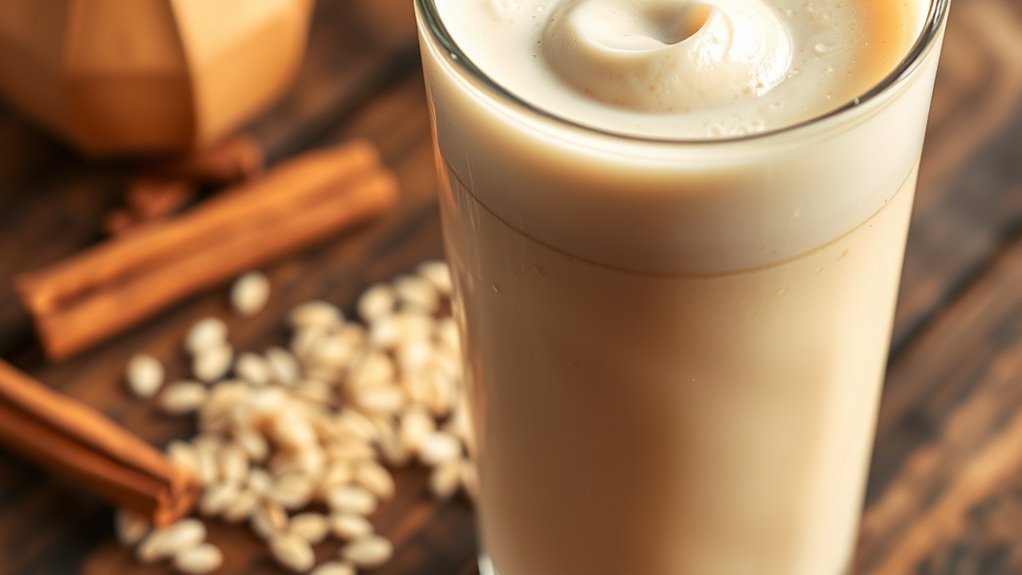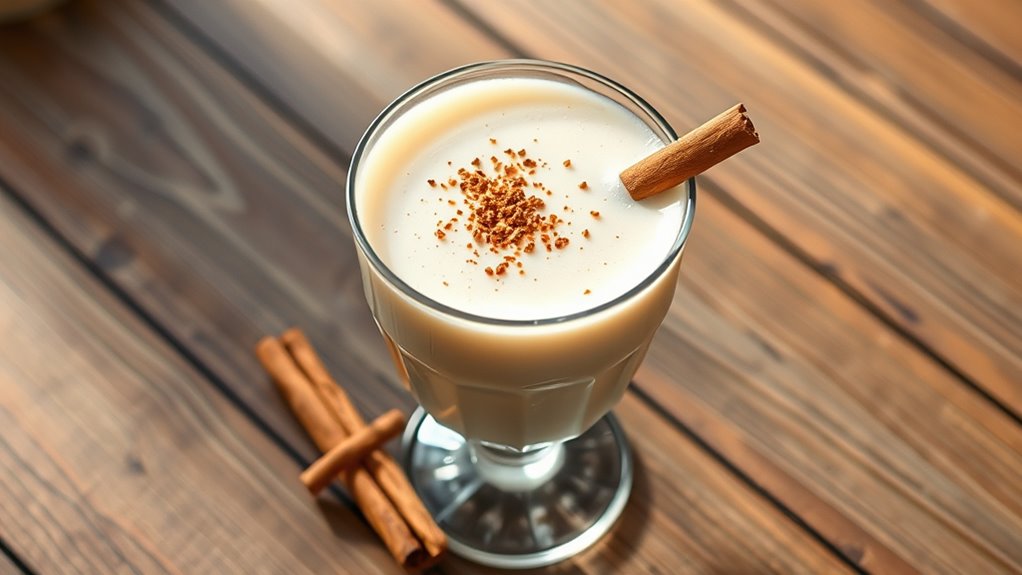For perfect horchata creaminess, use about 1 to 1.5 cups of dairy-free milk, like almond or cashew, per cup of soaked rice and water. Blend thoroughly to guarantee a smooth, rich texture without becoming grainy or too thin. Adjust the milk amount gradually, tasting along the way to balance sweetness and creaminess. Keep experimenting with ratios to find what tastes best—if you keep exploring, you’ll reveal the secrets of ideal consistency.
Key Takeaways
- Use about 1 to 1.5 cups of plant-based milk per 1 cup of rice and water mixture for optimal creaminess.
- Incorporate thorough blending to achieve a smooth, rich texture and prevent graininess.
- Adjust the dairy alternative gradually, tasting to balance creaminess without diluting sweetness.
- Select coconut or cashew milk for added richness, and modify quantities based on desired thickness.
- Fine-tune the ratio according to personal preference, ensuring a harmonious balance of flavor and smooth mouthfeel.

Horchata’s appeal often hinges on its perfect creaminess, which balances the drink’s natural sweetness and grainy texture. Achieving this ideal consistency involves understanding how different ingredients come together to create that smooth, rich mouthfeel. If you’re experimenting with dairy alternatives, you have more flexibility to tailor the creaminess to your liking. Plant-based milks like almond, coconut, or cashew milk can add unique flavors and textures, but it’s vital to select options that complement the rice base without overpowering it. Some dairy-free milks are thinner or less creamy than traditional milk, so you might need to adjust the amount you add to reach that perfect balance. Coconut milk, for example, provides a natural richness and a hint of tropical flavor, enhancing the overall creaminess. Almond milk offers a lighter, nutty note, while cashew milk tends to be creamier and more neutral, helping to maintain that smooth texture.
Balancing flavor is just as important as getting the right texture. Too much liquid can dilute the sweetness and make the horchata feel thin, while too little can result in an overly thick, grainy drink. When using dairy alternatives, start with a moderate amount and gradually add more until you reach your preferred consistency. Blending thoroughly helps incorporate the ingredients smoothly, ensuring the rice and flavorings are well incorporated into the liquid base. Adding a touch of sugar or sweetener can also help enhance the flavor and balance out any graininess from the rice. Remember, the key is to maintain a harmonious blend of sweetness, creaminess, and grainy texture. Additionally, understanding the content balance can help you achieve the ideal horchata consistency. Using proper ingredient proportions is essential to avoid over-thickening or watering down the drink, and can be adjusted based on your personal taste preferences. Incorporating texture considerations can further refine the drink’s mouthfeel, ensuring it is both rich and smooth. Incorporating techniques for blending can also improve the overall smoothness and consistency of the drink.
To fine-tune the flavor balancing, consider your personal taste preferences. If you enjoy richer drinks, opt for creamier dairy alternatives like coconut or cashew milk. If you prefer a lighter, more invigorating version, stick to almond milk or dilute your base slightly. The ideal ratio varies depending on these choices, but a good rule of thumb is to use about 1 to 1.5 cups of dairy alternative for every cup of rice and water mixture. This proportion ensures a creamy enough texture without making the drink overly dense. Tasting as you go is vital—adjust the amount of dairy alternative and sweetener to suit your palate. Ultimately, the perfect horchata is a harmonious blend of ingredients, with the right ratio of dairy alternatives to achieve that coveted creaminess while maintaining balanced flavors.
Frequently Asked Questions
Can I Substitute Almond Milk for Traditional Rice in Horchata?
You can definitely try an almond milk substitution in your horchata, but keep in mind it will change the flavor and texture. Traditional rice provides a neutral base, so consider rice alternative options like oats or cashews if you want a creamier consistency. Using almond milk alone might make your horchata less authentic, but it’s a tasty dairy-free option that’s quick and easy to prepare.
How Does Humidity Affect the Horchata Creaminess Ratio?
Humidity is like a silent artist shaping your horchata’s creaminess. When humidity impacts your environment, it can make your drink thinner or thicker than intended. You might need to adjust the creaminess ratio by adding more milk or rice to balance the texture. Keep an eye on the weather, and don’t be afraid to tweak your ingredients until your horchata hits that perfect, velvety consistency you crave.
Is There a Vegan Alternative to Dairy Cream in Horchata?
Yes, you can use a plant-based cream like coconut milk as a vegan alternative to dairy cream in horchata. Coconut milk adds a rich, creamy texture and subtle sweetness, making it a great substitute. Simply replace dairy cream with coconut milk in your recipe, adjusting the amount to achieve your desired creaminess. This way, you enjoy a delicious, vegan horchata without compromising on flavor or texture.
What’S the Best Way to Store Leftover Horchata?
You might think leftover horchata stays fresh forever, but proper storage tips matter for flavor preservation. To keep it tasting great, store it in an airtight container in the fridge, ideally within two hours of making it. Shake or stir it well before serving, as ingredients can settle. Consume within 1-2 days for the best flavor, and avoid leaving it out at room temperature to prevent spoilage.
How Long Does Homemade Horchata Stay Fresh?
Homemade horchata stays fresh for about 2 to 3 days when stored properly in an airtight container in the refrigerator. To preserve its freshness, make sure to keep it chilled and stir it well before serving, as separation may occur. Avoid leaving it out at room temperature for extended periods, as this can spoil the drink faster. For best results, consume it within this storage duration to enjoy ideal flavor and freshness.
Conclusion
Once you find that perfect balance, making horchata becomes like blending a symphony—each note in harmony. I once added a splash too much milk and ended up with a runny drink, like a watercolor bleeding on paper. But when I nailed the ratio, it was just right—creamy and smooth, like velvet. Keep experimenting until your horchata hits that sweet spot, turning every sip into a comforting, delicious experience.










